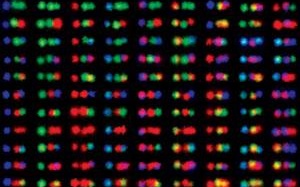A University scientist has found that a one-celled green plant, an alga, duplicates its transmitters of genetic information (DNA) in the same way as bacteria. This discovery of Noboru Sueoka, research fellow in Biology, reinforces the theory that at the fundamental level of biochemistry, most living processes are the same.
DNA (deoxyribonucleic acid) occurs in all living cells as long chains of molecules. In reproduction it passes on a "blueprint" governing cellular chemical events. Sueoka has shown that when a cell of the green alga, Chlamydomonas reinhardi, divides into two daughter cells, the new cells each contain half of the original DNA molecule and also a newly synthesized portion.
In a model of DNA's structure worked out by F. H. C. Crick of Cambridge University and J. D. Watson of Harvard, long strands of atoms are coiled together to make a spiral. Pairs of molecules called "nitrogen bases" connect the coils, which unwind in the process of duplication and assemble themselves on new strands. A series of experiments done a year ago at the California Institute of Technology, after which Sueoka patterned his experiments, supports this hypothesis.
DNA Becomes "Labeled"
Sueoka grew the algae in a nutrient medium containing an isotope of nitrogen with an extra neutron in its nucleus. Since DNA contains nitrogen, newly synthesized cells become "labeled" or marked with the heavy nitrogen.
After allowing them to divide in the medium for several days, Sueoka transferred the cells with heavy DNA to a medium with normal nitrogen. Two hours later he extracted some DNA from these cells and found that it had a molecular density half-way between heavy and normal DNA. It appeared as though the heavy DNA had separated into two heavy strands and each had manufactured a new partner containing normal nitrogen.
There was no more normal DNA, but after six hours the medium DNA had divided to produce some original and normal DNA that again confirmed the theory of reproduction.
Read more in News
Dennis to Give TalkRecommended Articles
-
Alum Develops DNA Sequencing SystemWhile scientists around the world were quibbling over methods to map out the human genome in 1997, Eugene Chan ’96
-
Harvard Team Isolates The GeneA team of scientists at the Harvard Medical School has succeeded in isolating a single gene-the basic unit of heredity.
-
Class Spurs Interest In ResearchAlly M. Freedy ’14 came to Harvard leaning heavily towards becoming a Neurobiology concentrator. At the beginning of freshman spring, she sought out research opportunities and secured a position in the lab of molecular and cellular biology professor Takaoa K. Hensch ’88, studying brain development.
-
Karthinking About PartyingThis week—with my last column ever—I’d like to Karthink about my morally hazardous justification for the benefit of my similarly hesitant peers: Partying all May will make you live longer.
-
 Crimes at Harvard and Wartime House Life
Crimes at Harvard and Wartime House Life -
 Scientists Develop DNA Barcoding
Scientists Develop DNA Barcoding













